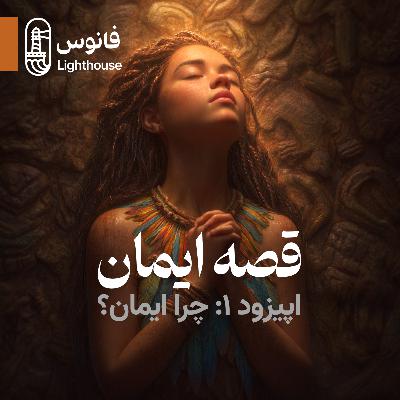اپیزود اول: چرا ایمان
Description
اپیزود اول «داستان ایمان» شما را به نخستین جرقّههای پرسشگری بشر میبَرد؛ به شبی تاریک در دلِ غار که جرقّهٔ آتش روی دیوار میرقصد و تا روشنایی آزمایشگاههای fMRI امروز امتداد مییابد. در این قسمت سرِ نخِ ایمان را از روزگاری میگیریم که هنوز واژهای به نام «دین» وجود نداشت، امّا انسانِ شکارچیـگردآورنده با نقشی از «شیرِ انسانگون» یا خاک سرخی بر مزار عزیزانش، نشانهای از معنای فراتر میجست.
در خلال روایت، از سازوکار مغزیِ «HADD» و نظریهٔ ذهن میگوییم تا بفهمیم چرا مغز ما هر خشخشی را ارادهٔ یک عامل پنهان میپندارد و چگونه همین تمایل، بستر باور به ارواح و خدایان شد. ردِ مقدّس را در هیروفانیِ الیاده دنبال میکنیم؛ لحظهای که سنگی معمولی به دروازهای قدسی بدل میشود و زمان و مکان را دوپاره میکند. سپس پای دورکیم، بویر و دیگر اندیشمندان به میان میآید تا ببینیم آیینها چگونه «شور جمعی» میسازند و چرا دین، از احساس تا نهاد، به ساماندهندهٔ زندگی اجتماعی بدل شد.
این اپیزود دعوتی است به نشستن کنار آتشِ نخستین انسان و شنیدن طنین همان پرسشهای جاودان: آیا کسی آن بیرون هست؟ رنج چرا وجود دارد؟ و پس از مرگ چه میشود؟ آماده باشید تا مسیر هزاران سالهٔ این پرسشها را، از دیوارهای غار تا صفحهٔ مغزنگاری، گامبهگام با هم طی کنیم.
توسط دانیال کشانی
---
منابع
- Barrett, J. L. (2012). Born Believers: The Science of Children’s Religious Belief. Free Press.
- Bering, J. M., & Bjorklund, D. F. (2004). The natural emergence of reasoning about the afterlife. Developmental Psychology, 40(2), 217–233. https://psycnet.apa.org/record/2004-13328-002
- Boyer, P. (2001). Religion Explained: The Evolutionary Origins of Religious Thought. Basic Books.
- Corriveau, K. H., Chen, E. E., & Harris, P. L. (2014). Judgments about fact and fiction by children from religious and nonreligious backgrounds. Cognitive Science, 39(2), 353–382. https://onlinelibrary.wiley.com/doi/abs/10.1111/cogs.12138
- Durkheim, É. (1912). The Elementary Forms of Religious Life (J. W. Swain, Trans.). George Allen & Unwin. https://archive.org/details/elementaryformso00durk
- Eliade, M. (1957). The Sacred and the Profane: The Nature of Religion (W. R. Trask, Trans.). Harcourt, Brace & World. https://archive.org/details/sacredprofane00mirc
- Gargett, R. H. (1999). Middle Palaeolithic burial is not a dead issue: The view from Qafzeh, Saint-Césaire, Kebara, Amud, and Dederiyeh. Journal of Human Evolution, 37(1), 27–90. https://www.sciencedirect.com/science/article/abs/pii/S0047248498902915
- Johnson, D. (2015). God Is Watching You: How the Fear of God Makes Us Human. Oxford University Press. https://academic.oup.com/book/32140
- Kelemen, D., & Rosset, E. (2009). The human function compunction: Teleological explanation in adults. Cognition, 111(1), 138–143. https://www.sciencedirect.com/science/article/abs/pii/S0010027708002237
- Kind, C.-J., et al. (2014). The smile of the Lion Man: Recent excavations in Stadel Cave. Quartär, 61, 129–145. https://www.researchgate.net/publication/260127249_The_Smile_of_the_Lion_Man_Recent_Excavations_in_Stadel_Cave
- Lewis-Williams, D. (2002). The Mind in the Cave: Consciousness and the Origins of Art. Thames & Hudson. https://books.google.com/books?id=gdU3AQAAIAAJ
- Marx, K. (1843). Critique of Hegel’s Philosophy of Right. Deutsch-Französische Jahrbücher. https://www.marxists.org/archive/marx/works/1843/critique-hpr/intro.htm
- Newberg, A., & Waldman, M. R. (2009). How God Changes Your Brain: Breakthrough Findings from a Leading Neuroscientist. Ballantine Books. https://books.google.com/books?id=3zY1S0T1Y2kC
- Schmidt, K. (2010). Göbekli Tepe – The Stone Age sanctuaries. Archaeological Discovery. https://www.academia.edu/1327500/Gobekli_Tepe_The_Stone_Age_Sanctuaries
- Tylor, E. B. (1871). Primitive Culture. John Murray. https://archive.org/details/primitiveculture01tylouoft
- Weber, M. (1905). The Protestant Ethic and the Spirit of Capitalism (T. Parsons, Trans.). Routledge. https://archive.org/details/protestantethics00webe
- Woolley, J. D., & Cox, V. (2007). Development of beliefs about storybook reality. Developmental Science, 10(5), 681–693. https://onlinelibrary.wiley.com/doi/abs/10.1111/j.1467-7687.2007.00612.x
- Armstrong, K. (1993). A history of God: The 4,000-year quest of Judaism, Christianity, and Islam. Knopf.
- McGrath, A. E. (2012). Historical theology: An introduction to Christian doctrine. Wiley-Blackwell.
- Noll, M. A. (2002). The rise of evangelicalism: The age of Edwards, Whitefield and the Wesleys. InterVarsity Press.
- Wilken, R. L. (2012). The first thousand years: A global history of Christianity. Yale University Press.
- Brown, P. (2013). The rise of Western Christendom: Triumph and diversity, A.D. 200-1000 (10th anniversary ed.). Wiley-Blackwell.
- Davies, N. (1996). Europe: A history. Oxford University Press.
- MacCulloch, D. (2009). A history of Christianity: The first three thousand years. Penguin.
- Pelikan, J. (1971). The Christian tradition: A history of the development of doctrine (Vol. 1: The emergence of the Catholic tradition, 100-600). University of Chicago Press.







محتوا خوب بود ولی خیلی موزیکال بود تعداد اهنگ ها تو ماچ بود واقعا
سلام. امیدوارم پزوهشتون باز هم ادامه پیدا کند. در سایت عدم خشونت، دو تا گزارش هست از نشنال جیاگرافیک: - زایش دین و - مورمونها هر دو در بارهی ایمان و دین، و منشا آن، و چرایی باور و ایمان خیل مردم به ادعاهای بسیار بزرگِ بدون اسناد و شواهد بسیار بزرگ اند. . بد نیست همگان تاملی بر آن ها داشته باشند. با احترام.
اسم این آهنگی که با صدای هاله صیفیزاده دقیقه ۱۱ هست چیه؟
چه موضوع جذاب و نوای، ای کاش یا در خوانش و گویندگی دقت میفرمودین و یا از گوینده حرفهای استفاده میکردید. خوانش و ادای کلمات و جابجایی ضرباهنگ روایت باعث بسیاری از واژهها را متوجه نوشم و علیرغم جذابیت موضوع آن را نیمه رها کردم. نکته دیگر اینکه حجم موسیقی برای این موضوع زیاد است. موفق باشید
چرا انقدر موسیقی داره بین صحبتا!
درود. ممنون بابت زحمتی که برای ساخت این اپیزود کشیدید. بی صبرانه منتظر قسمت های بعدی هستم.
با تشکر از شما جالب بود فقط اون اهنگ اخری رومن هرجا گشتم نتونستم پیدا کنم ممکنه کمکم کنین؟؟
درود اپیزود بسیار جالب و تأمل برانگیزی بود.🙏🏻